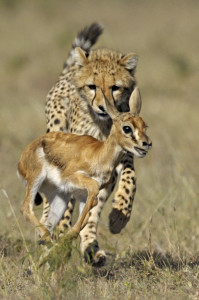 There’s a huge difference between a cheetah in a cage and a cheetah in the wild. The cheetah is one of my most favorite animals to see when I go on safari. No matter how many times I see them it never gets old. Once our group had the thrill of watching a cheetah on the hunt. She moved with purpose and grace. Not a single step was wasted as she stalked her prey.
There’s a huge difference between a cheetah in a cage and a cheetah in the wild. The cheetah is one of my most favorite animals to see when I go on safari. No matter how many times I see them it never gets old. Once our group had the thrill of watching a cheetah on the hunt. She moved with purpose and grace. Not a single step was wasted as she stalked her prey.
A cheetah in a cage is one of the saddest things you’ll ever see. This graceful animal full of energy and built for speed paces endlessly back and forth. It has no purpose in its movement. It is all nervous energy with no place to put it and those who watch it, if they’ve seen a cheetah in the wild, just feel sorry for the animal.
One of the most distracting things a speaker can do is pace like a caged cheetah. Random, unfocused pacing when you’re presenting makes the audience uncomfortable. Especially audiences that have seen excellent speakers in their natural habitat. If you’ve been following my advice you know that I’ve taken you out from behind the safety of a podium, taken your hands out of your pockets and made you look at your audience. All of these things can lead to nervousness, which can come out as pacing. Now I’m telling you not to do that!
I’m not saying you shouldn’t move on stage. What I am saying is that you should move like a cheetah in the wild. With purpose in every step. In some ways it’s like you’re stalking your audience to capture them with the point you’re making. In order to move with purpose you first have to be rock solid certain of your purpose. If you don’t know the point you’re trying to make then go ahead and pace because it doesn’t matter anyway!
But if you have a point to make and important information, thoughts, anecdotes to share to highlight your point then those become your motivation to move. Position yourself on stage, lock eyes with the audience and share what you have to say (thought, story, anecdote, factoid) then pause and move. Your movement can be as subtle as a turn to look at a different segment of the audience or as obvious as walking to another part of the stage and locking eyes with the folks in that part of the room. Start your next point and don’t move again until the movement helps to make the point, conclude the thought or emphasize the concept.
At first you’ll make the mistake of moving every time you have a new comment, thought or point. That becomes predictable and obvious. You don’t have to move every time, but every time you move it should accomplish something in your presentation. Again, map it out in your notes. Consider where you want to move and how you want to move. If you’re communicating excitement you might move quickly with lots of energy and stop abruptly. If you’re communicating thoughtfulness or contemplation you might move slowly with your head down as you ponder something important and drift to a stop as you lift your eyes to the audience and share the thought. Always remember you’re presenting with your whole body.
An animal in its wild natural habitat is beautiful. A caged animal is sad and pathetic. When it comes to movement…be natural.
Leave a Reply